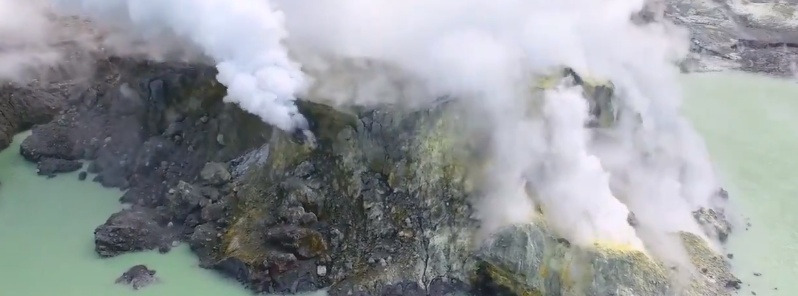White Island crater lake growing, hydrothermal surface activity possible, New Zealand

The Crater Lake at White Island volcano in New Zealand continues to grow, which may cause hydrothermal surface activity, GeoNet Duty Volcanologist Brad Scott said Volcanic Alert Bulletin for White Island released July 4, 2018. The Volcanic Alert Level remains at 1.
"As the water level rises it is encroaching on the larger and hotter gas vents on the 2012 lava dome area and will soon start to drown them," Scott said. "Changes in surface hydrothermal activity are expected as vents are drowned. However, it is uncertain what form this will take," he said.
Previous lakes have flooded active gas vents and larger scale fumaroles. These vents and fumaroles have been slightly different each time, ranging from wide open vent areas in depressions to individual fumaroles and contrast with the dome environment now present.
Drowning of these vents has usually lead to localized steam driven activity; geysering and small hydrothermal eruptions. Some have formed small debris-tuff cones around the active areas during the more violent hydrothermal activity, but it is difficult to quantify the style of activity that will occur as the vents are drowned.
Visitors to the island experienced loud sounds from the active crater area in April in May 2018, Scott said, adding that these have now stopped as the geothermal system adjusts to the new lake.
We gave you a little teaser late last week, but here's some incredible footage from our team's recent trip out to White Island (Whakaari). It's a great visual to accompany the Volcanic Alert Bulletin we put out earlier today #volcanonz #WhiteIslandWednesday pic.twitter.com/hS6PmHzZ2O
— GeoNet (@geonet) July 4, 2018
If the lake continues to fill at the current rate it is expected the features on the side of the dome will be drowned early to mid-August and the dome will be totally drowned in 3 to 4 months’ time. The lake is now 17 m (55 feet) below overflow and is filling at about 2 000 m3 (70 630 feet3) per day. This is essentially the same rate as seen in 2003 and 2004, 2007 and 2008 and 2013.
Observations during a recent monitoring visit to the Island confirmed volcanic activity remains at a steady and low level.
The gas rich vents on the western side of the active crater (the Dome area) continue to emit hot, clear gas.
The maximum temperature obtained from the vents on the dome was 244 °C (471 °F), representing a slight rise. While the temperature of Fumarole Zero continues to decline, now measuring 138 °C (280 °F), the seismic and acoustic activity generally remain low, and the SO2 gas flux is also low. The lake temperature is 30.4 °C (86.7 °F). The ground deformation survey confirms the subsidence pattern towards the active vents continues.
"There is no substantial change in the level of volcanic activity at White Island," Scott said. "Crater Lakes have formed in the past and we do see changes in the geothermal activity associated with this, but no signs of increased volcanic unrest. Therefore, current observations are consistent with minor volcanic unrest behavior and because of this, we remain at Volcanic Alert Level 1 and the Aviation Colour Code stays at Green."
Volcano Alert Level 1 corresponds to minor volcanic unrest and the associated hazards. While this is the case, it is a useful reminder that eruptions can occur with little or no warning.
Featured image: White Island, New Zealand – June 2018. Credit: GNS/GeoNet

Commenting rules and guidelines
We value the thoughts and opinions of our readers and welcome healthy discussions on our website. In order to maintain a respectful and positive community, we ask that all commenters follow these rules.